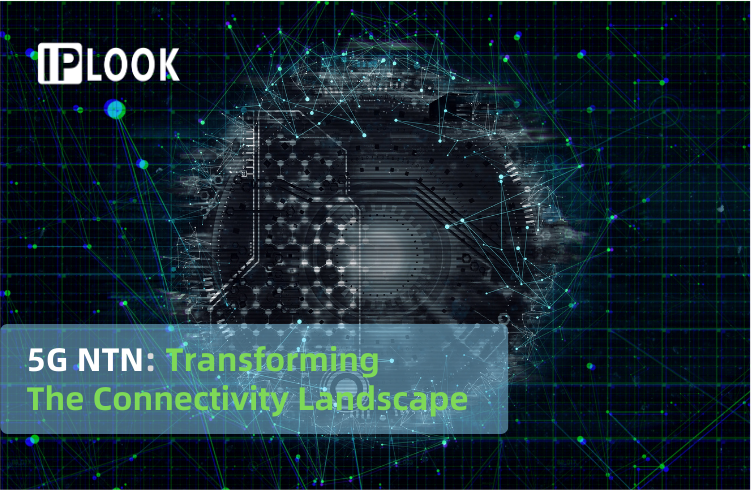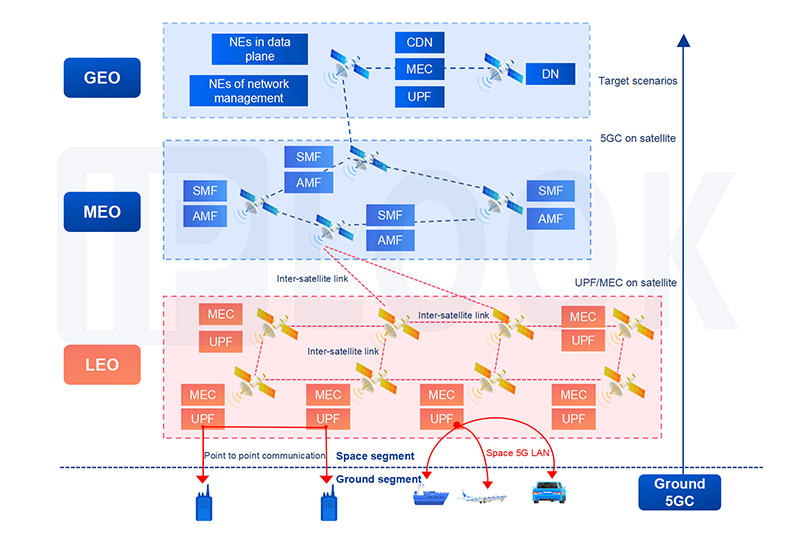
Non-Terrestrial Networks (NTN) is a terminal-satellite direct communication technology based on the new radio (NR) interface technology developed by 3GPP in R17. As a supplement to the terrestrial cellular network, NTN enables space-air-ground integrated network (SAGIN) beyond ground-based infrastructure in bandwidth, latency, reliability, etc. It provides seamless network services to global users by providing larger coverage and resilience, satisfying the future network requirements on all-time, all-domain, and all-space communications and interconnected networking.
NTN wireless communication involves low Earth orbit (LEO) satellites, medium Earth orbit (MEO) satellites and geostationary orbit (GEO) satellites that operate above the Earth's surface to offer reliable and stable network connectivity. Deploying core network on satellites can leverage the competence of terrestrial mobile core network and extend its applications.

A significant portion of land and marine areas, around 80% and 95% respectively, lack coverage from terrestrial cellular networks. To ensure ubiquitous mobile network access, 5G networks must extend beyond these limitations. However, building and maintaining 5G terrestrial networks in remote locations like mountains, deserts, and oceans are daunting challenges. 5G NTN offers a solution by using Phased Array Antennas, mmWave technology, Adaptive beamforming..etc, to help bridging the digital divide and connecting the unconnected.
· Expanded Coverage and Connectivity
5G NTN overcomes limitations faced by traditional networks, providing high-speed internet access to remote regions, rural areas, and disaster-stricken zones. Satellite-based networks cover vast expanses of land, while drones and High-Altitude Platforms (HAPs) offer temporary or on-demand coverage during emergencies or events.
· Enabling IoT and Smart Cities
5G NTN unlocks the potential for IoT deployment and smart city development. It facilitates real-time connectivity among devices and sensors, leading to improved automation, enhanced public services, and optimized resource management. Applications range from smart grids to connected healthcare and environmental monitoring.
· Redundancy
By offering an alternative communication channel, 5G NTN ensures connectivity even if the terrestrial network is affected or destroyed. Satellite or aerial platforms serve as backup options, guaranteeing uninterrupted service.
While 5G NTN holds immense promise, it also presents challenges. Coordinating between terrestrial and non-terrestrial networks, managing handovers, and ensuring seamless connectivity across platforms require robust infrastructure and efficient network management systems. Regulatory frameworks, spectrum allocation, and international cooperation are crucial for harnessing the full potential of 5G NTN.
Moreover, the main difficulties of NTN networks are the high latency (up to 120 ms for GSO satellites) and the deep fade (up to 170 dB) due to the orbital altitude of the satellites, as well as the large doppler (tens of kHz) introduced by the high-speed movement of low-orbit satellites. For the deep fade, the transmission and reception capabilities are usually improved by increasing the size of the antenna and panel on the satellite side to ensure that the unmodified smartphones can also carry out satellite communication normally; as for delay and Doppler, 3GPP has formulated a series of solutions in the protocol, so that terminals and base stations can confirm the delay and Doppler changes through satellite ephemeris information, and complete compensation at the transmitter to ensure the normal progress of communication.
3GPP R18 for NR introduces enhancements to support NTN connectivity, including:
· Expansion of NR (FDD mode) NTN into frequency bands exceeding 10 GHz, such as the Ka-band, to accommodate VSAT (Very Small Aperture Terminal) devices. VSAT terminals possess higher antenna gain and transmit power, making them suitable for installation on airborne, maritime, or land-based vehicles to provide broadband data services. These frequency bands will not be accessible for handheld user equipment (UE) and IoT devices due to the significant path loss experienced at higher frequencies.
· Enhancement of coverage for low-data rate and VoIP (Voice over Internet Protocol) services through commercial smartphones in NTN scenarios. VoIP is specifically applicable to LEO satellites due to the latency associated with longer propagation distances, while low-data rate services can be offered by all satellite types (LEO, MEO, GEO) through sufficient repetitions of transmissions.
· Improvement of UE mobility within NTN earth-fixed and earthmoving cells, as well as mobility between NTN and terrestrial networks, to ensure service continuity. This will be achieved through enhanced procedures for measurements, cell re-selection, and handover. Tracking areas will remain earth-fixed, similar to the specifications in R17.
· Network verification of UE location reports to fulfill regulatory requirements regarding accuracy, latency, reliability, and other factors. This verification is necessary for various purposes, including emergency calls, lawful intercept, public warnings, and charging/billing processes.

